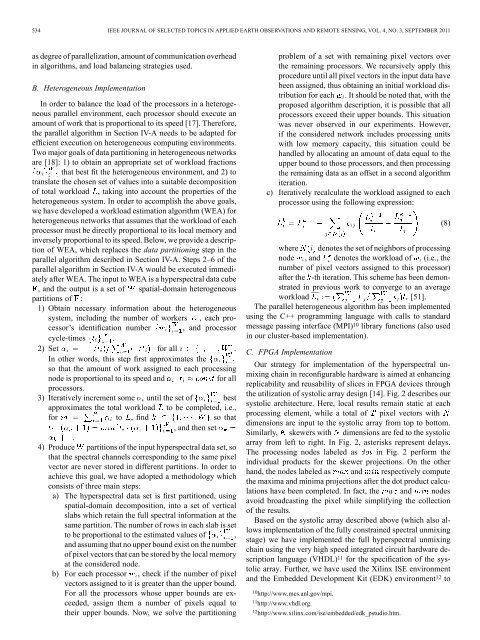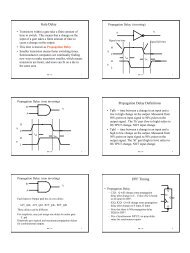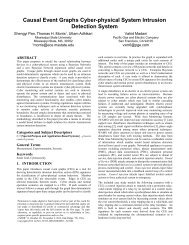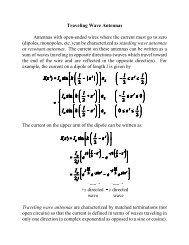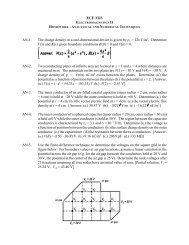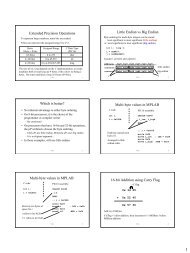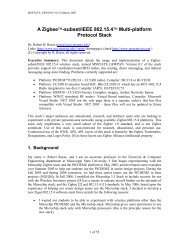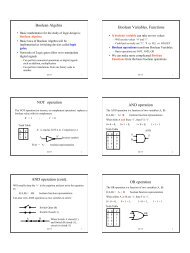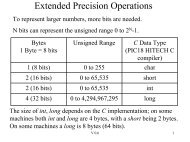High Performance Computing for Hyperspectral ... - IEEE Xplore
High Performance Computing for Hyperspectral ... - IEEE Xplore
High Performance Computing for Hyperspectral ... - IEEE Xplore
You also want an ePaper? Increase the reach of your titles
YUMPU automatically turns print PDFs into web optimized ePapers that Google loves.
534 <strong>IEEE</strong> JOURNAL OF SELECTED TOPICS IN APPLIED EARTH OBSERVATIONS AND REMOTE SENSING, VOL. 4, NO. 3, SEPTEMBER 2011<br />
as degree of parallelization, amount of communication overhead<br />
in algorithms, and load balancing strategies used.<br />
B. Heterogeneous Implementation<br />
In order to balance the load of the processors in a heterogeneous<br />
parallel environment, each processor should execute an<br />
amount of work that is proportional to its speed [17]. There<strong>for</strong>e,<br />
the parallel algorithm in Section IV-A needs to be adapted <strong>for</strong><br />
efficient execution on heterogeneous computing environments.<br />
Two major goals of data partitioning in heterogeneous networks<br />
are [18]: 1) to obtain an appropriate set of workload fractions<br />
that best fit the heterogeneous environment, and 2) to<br />
translate the chosen set of values into a suitable decomposition<br />
of total workload , taking into account the properties of the<br />
heterogeneous system. In order to accomplish the above goals,<br />
we have developed a workload estimation algorithm (WEA) <strong>for</strong><br />
heterogeneous networks that assumes that the workload of each<br />
processor must be directly proportional to its local memory and<br />
inversely proportional to its speed. Below, we provide a description<br />
of WEA, which replaces the data partitioning step in the<br />
parallel algorithm described in Section IV-A. Steps 2–6 of the<br />
parallel algorithm in Section IV-A would be executed immediately<br />
after WEA. The input to WEA is a hyperspectral data cube<br />
, and the output is a set of spatial-domain heterogeneous<br />
partitions of :<br />
1) Obtain necessary in<strong>for</strong>mation about the heterogeneous<br />
system, including the number of workers , each processor’s<br />
identification number , and processor<br />
cycle-times .<br />
2) Set <strong>for</strong> all .<br />
In other words, this step first approximates the<br />
so that the amount of work assigned to each processing<br />
node is proportional to its speed and<br />
<strong>for</strong> all<br />
processors.<br />
3) Iteratively increment some until the set of best<br />
approximates the total workload to be completed, i.e.,<br />
<strong>for</strong> to , find so that<br />
,andthenset<br />
.<br />
4) Produce partitions of the input hyperspectral data set, so<br />
that the spectral channels corresponding to the same pixel<br />
vector are never stored in different partitions. In order to<br />
achieve this goal, we have adopted a methodology which<br />
consists of three main steps:<br />
a) The hyperspectral data set is first partitioned, using<br />
spatial-domain decomposition, into a set of vertical<br />
slabs which retain the full spectral in<strong>for</strong>mation at the<br />
same partition. The number of rows in each slab is set<br />
to be proportional to the estimated values of ,<br />
and assuming that no upper bound exist on the number<br />
of pixel vectors that can be stored by the local memory<br />
at the considered node.<br />
b) For each processor , check if the number of pixel<br />
vectors assigned to it is greater than the upper bound.<br />
For all the processors whose upper bounds are exceeded,<br />
assign them a number of pixels equal to<br />
their upper bounds. Now, we solve the partitioning<br />
problem of a set with remaining pixel vectors over<br />
the remaining processors. We recursively apply this<br />
procedure until all pixel vectors in the input data have<br />
been assigned, thus obtaining an initial workload distribution<br />
<strong>for</strong> each . It should be noted that, with the<br />
proposed algorithm description, it is possible that all<br />
processors exceed their upper bounds. This situation<br />
was never observed in our experiments. However,<br />
if the considered network includes processing units<br />
with low memory capacity, this situation could be<br />
handled by allocating an amount of data equal to the<br />
upper bound to those processors, and then processing<br />
the remaining data as an offset in a second algorithm<br />
iteration.<br />
c) Iteratively recalculate the workload assigned to each<br />
processor using the following expression:<br />
where denotes the set of neighbors of processing<br />
node ,and denotes the workload of (i.e., the<br />
number of pixel vectors assigned to this processor)<br />
after the -th iteration. This scheme has been demonstrated<br />
in previous work to converge to an average<br />
workload [51].<br />
The parallel heterogeneous algorithm has been implemented<br />
using the C++ programming language with calls to standard<br />
message passing interface (MPI) 10 library functions (also used<br />
in our cluster-based implementation).<br />
C. FPGA Implementation<br />
Our strategy <strong>for</strong> implementation of the hyperspectral unmixing<br />
chain in reconfigurable hardware is aimed at enhancing<br />
replicability and reusability of slices in FPGA devices through<br />
the utilization of systolic array design [14]. Fig. 2 describes our<br />
systolic architecture. Here, local results remain static at each<br />
processing element, while a total of pixel vectors with<br />
dimensions are input to the systolic array from top to bottom.<br />
Similarly, skewers with dimensions are fed to the systolic<br />
array from left to right. In Fig. 2, asterisks represent delays.<br />
The processing nodes labeled as in Fig. 2 per<strong>for</strong>m the<br />
individual products <strong>for</strong> the skewer projections. On the other<br />
hand, the nodes labeled as and respectively compute<br />
the maxima and minima projections after the dot product calculations<br />
have been completed. In fact, the and nodes<br />
avoid broadcasting the pixel while simplifying the collection<br />
of the results.<br />
Based on the systolic array described above (which also allows<br />
implementation of the fully constrained spectral unmixing<br />
stage) we have implemented the full hyperspectral unmixing<br />
chain using the very high speed integrated circuit hardware description<br />
language (VHDL) 11 <strong>for</strong> the specification of the systolic<br />
array. Further, we have used the Xilinx ISE environment<br />
and the Embedded Development Kit (EDK) environment 12 to<br />
10 http://www.mcs.anl.gov/mpi.<br />
11 http://www.vhdl.org.<br />
12 http://www.xilinx.com/ise/embedded/edk_pstudio.htm.<br />
(8)


